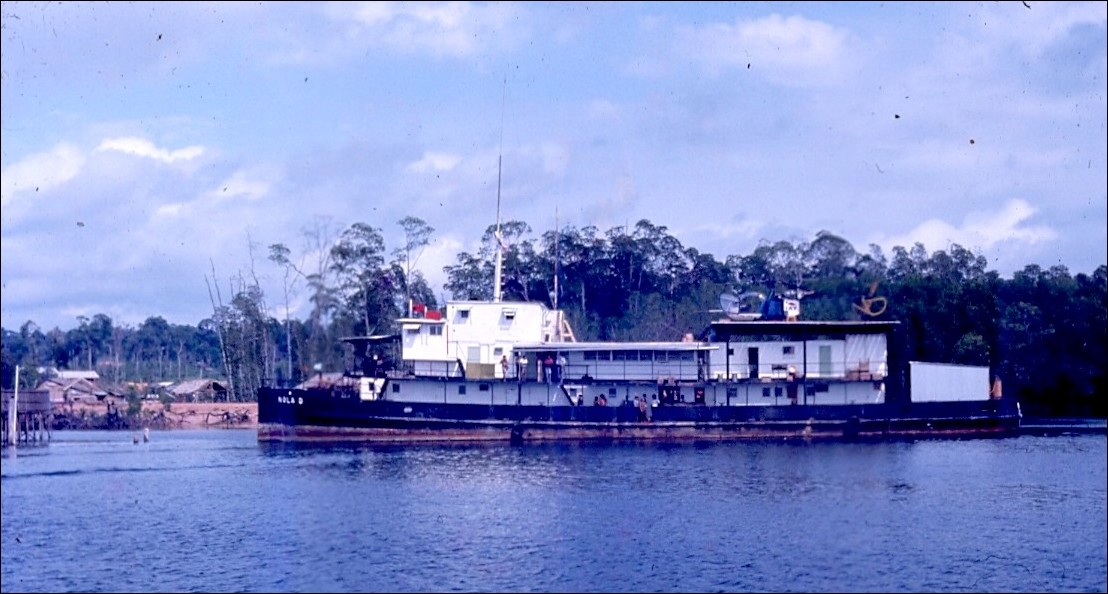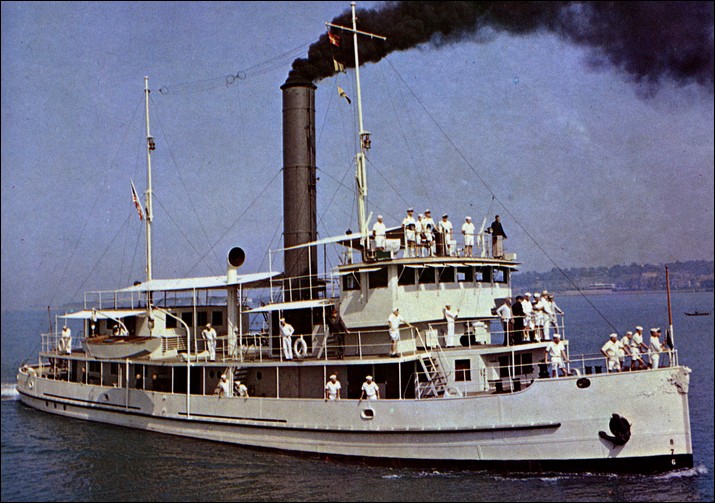"But perhaps the real star of the film is a 150-foot steel-hulled gunboat, built by Vaughn & Yung (incorrectly spelled Jung) Engineering Ltd. of Hong Kong. The San Pablo herself, river-going home of The Sand Pebbles. An authentic replica of one type of U.S. navy gunboat used in China in the 1920's, the current San Pablo is powered with a diesel engine, will "sleep" a caretaker crew of six and is an ocean-going vessel capable of ten knots. She made the voyage by sea from Hong Kong to Taiwan and then back to Hong Kong, attesting to her stability."
For many years fans have wondered what had become of the movie ship, the San Pablo. The movie souvenir book simply stated that:
"Upon completion of The Sand Pebbles, the San Pablo was saved from the scrap heap - the fate of all gunboats - by an American construction firm which had a contract to rebuild bridges in Viet Nam. The ship went back to the Vaughn & Yung yards for some minor alterations and today is serving as a floating hotel and dormitory for American construction crews working behind the battle areas."
A national wire service story, dated August 29, 1966, basically told the same story of the San Pablo's future:
"Movie Gunboat To Become Hotel - The USS San Pablo, quarter-million-dollar 150-foot gunboat built for Robert Wise's The Sand Pebbles has been sold to Hong Kong interests and will serve the war effort in South Viet Nam as a floating hotel. The San Pablo, replica of gunboats that plied the Yangtze during the 1920's, will be towed to Saigon this month. The buyers, Vaughn & Yung, Ltd., will charter the vessel after conversion. Spokemen for the company said it will be used to house American engineers involved in dock construction in Saigon. The ship was built in Hong Kong last year." Newspaper clipping.
After this nothing else was known about the fate of the San Pablo until I received a letter on November 4, 2008 from Murray Bollen, Mandurah West Australia:
"...In 1975, I came across the "Nola D" - engineless and forlorn against a dock in Tarakan Indonesia. She was being used as a base camp/accommodation camp for a seismic survey company Delta Exploration, then a Houston Based company. I was at the time working on one of their other vessels, the Rio Das Contas and happened to see her in Tarakan. I did not realise what the significance of the vessel was as I had not seen the movie at that time. Only years later I saw the movie and can virtually confirm her to be one and the same."
On March 29, 2009 I received a letter (with photo) from Horrie Hunt, Australia:
"I noted that no one has come forward with info on the San Pablo. After the movie I believe it was sold to the De Long Timber Co. in the Philippines. It was renamed the “Nola D” after Nola Dianne Delong the owner's wife or daughter. It was later sold to Seiscom Delta Exploration Co. and used as a base camp in Indonesia until the mid 1970’s. I was on it in 1974 and have a photo of it at that time. Back deck turned into power house Helipad on the top. I lost track of it after that."

Then a follow-up letter from Horrie Hunt on April 2, 2009:
"...I have spoken to a person who was a supervisor at Delta Exploration at the time. He lives in this part of the world. Brisbane Australia.
Delta Exploration (later to become Seiscom Delta) purchased the Nola D in the very early 1970's. She was engineless then and had to be towed everywhere. The last job she was used on was in 1974-1975. This was in the area of the Mahakam River Delta and a place called Bontang in Indonesian Borneo. The photo was taken at Bontang. I last heard of her in a radio message as she was being towed to Jakarta I think in 1975. She was never used again and was sold and scrapped sometime in late 1975 or 1976. The bloke I was talking to is going to Jakarta next week and will ask around to find out about her final destination. Some of the people who worked there then are still in Indonesia. We may still be able to find out exactly what happened.
San Pablo. She was converted to a base camp for seismic operations. The area between the forward and aft cabins was built in and become a mess room. The aft top cabin area became the Kitchen, Cold rooms and accommodation for the cooks and cleaners. The area directly below was the mechanics workshop. The lower Middle area was the electronics and cable workshop, The forward Top and lower cabin sections were expat accommodation. The bridge (empty) was left bare. The below deck area (Coolie quarters in the movie ) was made into fresh water storage The engine had been removed. If I remember the prop steam engine was still in situ. Fuel tanks were built into the aft steering area. The Power shed was built onto the back deck. All in all she was probably the best base camp I ever stayed on. You could still see the name 'San Pablo' on the stern from where it was cut off.
Her construction was welded steel, and to make it look like she was a riveted steel boat, all the rivet heads were glued on plastic domes. The steel shutters on the bridge windows were still there and the gun turret mounts were still there. I'll let you know if I hear anymore..."
A final letter from Horrie Hunt on April 14, 2009:
"Have a reply back from Jakarta. The Nola D was taken to Singapore and broken up in 1975.
This is from the person who organised it."
My thanks to Horrie Hunt and Murray Bollen for providing the information here which has helped to answer the question - "What became of the San Pablo?" - CG
Return to the Sand Pebbles Index

